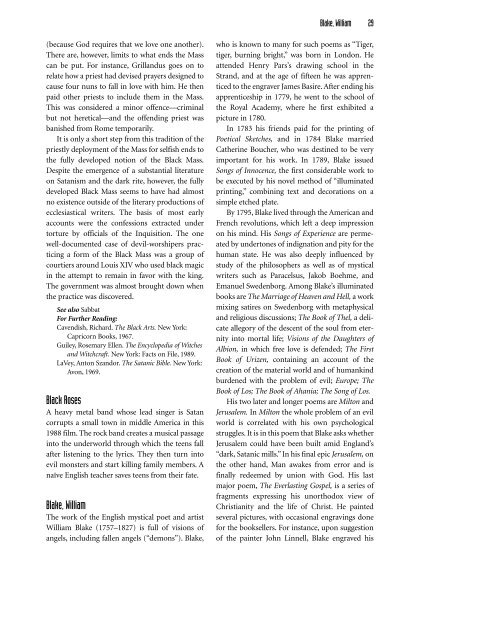Satanism Today - An Encyclopedia of Religion, Folklore and Popular ...
Satanism Today - An Encyclopedia of Religion, Folklore and Popular ...
Satanism Today - An Encyclopedia of Religion, Folklore and Popular ...
You also want an ePaper? Increase the reach of your titles
YUMPU automatically turns print PDFs into web optimized ePapers that Google loves.
Blake, William 29<br />
(because God requires that we love one another).<br />
There are, however, limits to what ends the Mass<br />
can be put. For instance, Grill<strong>and</strong>us goes on to<br />
relate how a priest had devised prayers designed to<br />
cause four nuns to fall in love with him. He then<br />
paid other priests to include them in the Mass.<br />
This was considered a minor <strong>of</strong>fence—criminal<br />
but not heretical—<strong>and</strong> the <strong>of</strong>fending priest was<br />
banished from Rome temporarily.<br />
It is only a short step from this tradition <strong>of</strong> the<br />
priestly deployment <strong>of</strong> the Mass for selfish ends to<br />
the fully developed notion <strong>of</strong> the Black Mass.<br />
Despite the emergence <strong>of</strong> a substantial literature<br />
on <strong>Satanism</strong> <strong>and</strong> the dark rite, however, the fully<br />
developed Black Mass seems to have had almost<br />
no existence outside <strong>of</strong> the literary productions <strong>of</strong><br />
ecclesiastical writers. The basis <strong>of</strong> most early<br />
accounts were the confessions extracted under<br />
torture by <strong>of</strong>ficials <strong>of</strong> the Inquisition. The one<br />
well-documented case <strong>of</strong> devil-worshipers practicing<br />
a form <strong>of</strong> the Black Mass was a group <strong>of</strong><br />
courtiers around Louis XIV who used black magic<br />
in the attempt to remain in favor with the king.<br />
The government was almost brought down when<br />
the practice was discovered.<br />
See also Sabbat<br />
For Further Reading:<br />
Cavendish, Richard. The Black Arts. New York:<br />
Capricorn Books, 1967.<br />
Guiley, Rosemary Ellen. The <strong>Encyclopedia</strong> <strong>of</strong> Witches<br />
<strong>and</strong> Witchcraft. New York: Facts on File, 1989.<br />
LaVey, <strong>An</strong>ton Sz<strong>and</strong>or. The Satanic Bible. New York:<br />
Avon, 1969.<br />
Black Roses<br />
A heavy metal b<strong>and</strong> whose lead singer is Satan<br />
corrupts a small town in middle America in this<br />
1988 film. The rock b<strong>and</strong> creates a musical passage<br />
into the underworld through which the teens fall<br />
after listening to the lyrics. They then turn into<br />
evil monsters <strong>and</strong> start killing family members. A<br />
naïve English teacher saves teens from their fate.<br />
Blake, William<br />
The work <strong>of</strong> the English mystical poet <strong>and</strong> artist<br />
William Blake (1757–1827) is full <strong>of</strong> visions <strong>of</strong><br />
angels, including fallen angels (“demons”). Blake,<br />
who is known to many for such poems as “Tiger,<br />
tiger, burning bright,” was born in London. He<br />
attended Henry Pars’s drawing school in the<br />
Str<strong>and</strong>, <strong>and</strong> at the age <strong>of</strong> fifteen he was apprenticed<br />
to the engraver James Basire. After ending his<br />
apprenticeship in 1779, he went to the school <strong>of</strong><br />
the Royal Academy, where he first exhibited a<br />
picture in 1780.<br />
In 1783 his friends paid for the printing <strong>of</strong><br />
Poetical Sketches, <strong>and</strong> in 1784 Blake married<br />
Catherine Boucher, who was destined to be very<br />
important for his work. In 1789, Blake issued<br />
Songs <strong>of</strong> Innocence, the first considerable work to<br />
be executed by his novel method <strong>of</strong> “illuminated<br />
printing,” combining text <strong>and</strong> decorations on a<br />
simple etched plate.<br />
By 1795, Blake lived through the American <strong>and</strong><br />
French revolutions, which left a deep impression<br />
on his mind. His Songs <strong>of</strong> Experience are permeated<br />
by undertones <strong>of</strong> indignation <strong>and</strong> pity for the<br />
human state. He was also deeply influenced by<br />
study <strong>of</strong> the philosophers as well as <strong>of</strong> mystical<br />
writers such as Paracelsus, Jakob Boehme, <strong>and</strong><br />
Emanuel Swedenborg. Among Blake’s illuminated<br />
books are The Marriage <strong>of</strong> Heaven <strong>and</strong> Hell, a work<br />
mixing satires on Swedenborg with metaphysical<br />
<strong>and</strong> religious discussions; The Book <strong>of</strong> Thel, a delicate<br />
allegory <strong>of</strong> the descent <strong>of</strong> the soul from eternity<br />
into mortal life; Visions <strong>of</strong> the Daughters <strong>of</strong><br />
Albion, in which free love is defended; The First<br />
Book <strong>of</strong> Urizen, containing an account <strong>of</strong> the<br />
creation <strong>of</strong> the material world <strong>and</strong> <strong>of</strong> humankind<br />
burdened with the problem <strong>of</strong> evil; Europe; The<br />
Book <strong>of</strong> Los; The Book <strong>of</strong> Ahania; The Song <strong>of</strong> Los.<br />
His two later <strong>and</strong> longer poems are Milton <strong>and</strong><br />
Jerusalem. In Milton the whole problem <strong>of</strong> an evil<br />
world is correlated with his own psychological<br />
struggles. It is in this poem that Blake asks whether<br />
Jerusalem could have been built amid Engl<strong>and</strong>’s<br />
“dark, Satanic mills.” In his final epic Jerusalem, on<br />
the other h<strong>and</strong>, Man awakes from error <strong>and</strong> is<br />
finally redeemed by union with God. His last<br />
major poem, The Everlasting Gospel, is a series <strong>of</strong><br />
fragments expressing his unorthodox view <strong>of</strong><br />
Christianity <strong>and</strong> the life <strong>of</strong> Christ. He painted<br />
several pictures, with occasional engravings done<br />
for the booksellers. For instance, upon suggestion<br />
<strong>of</strong> the painter John Linnell, Blake engraved his
















